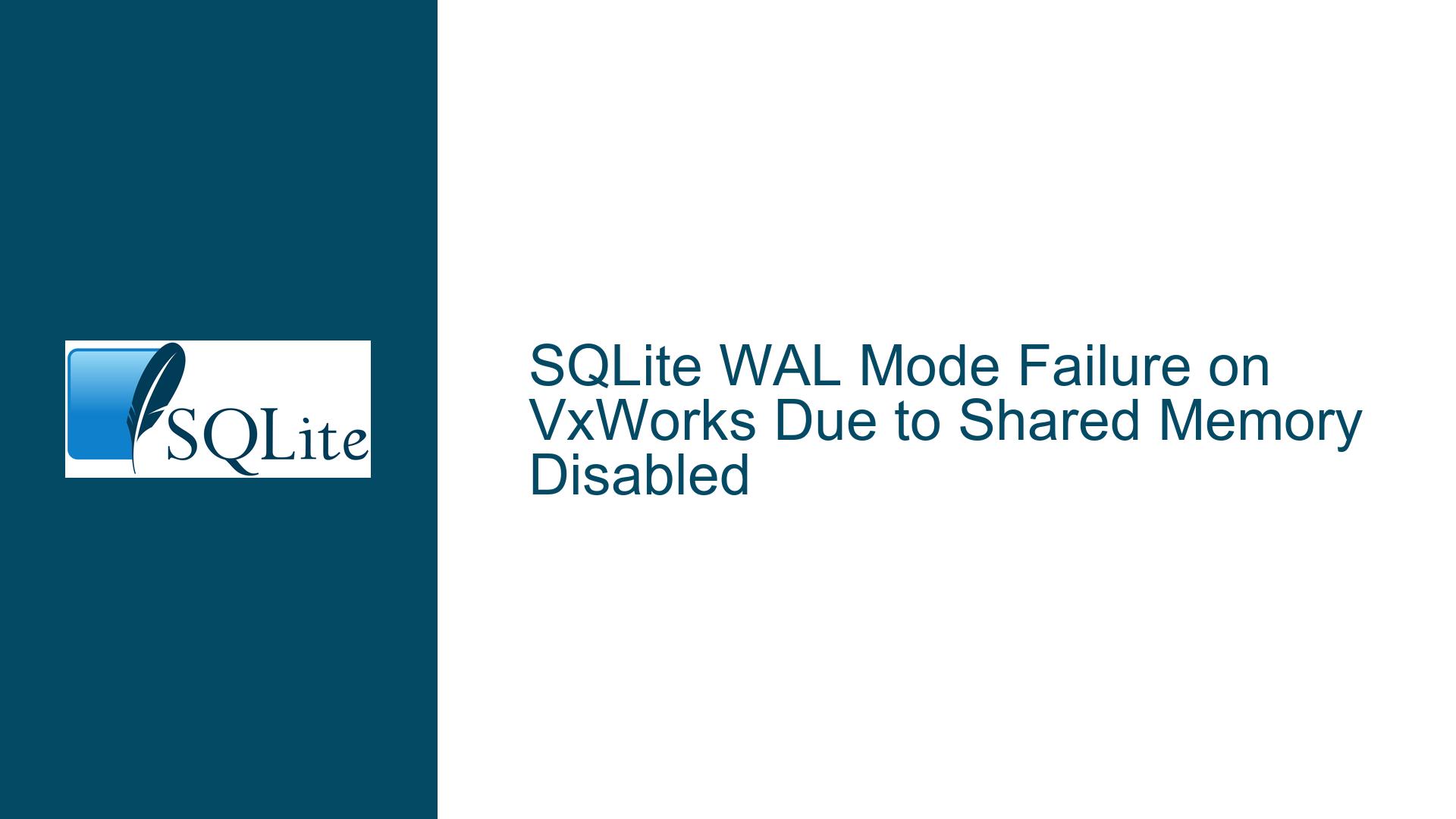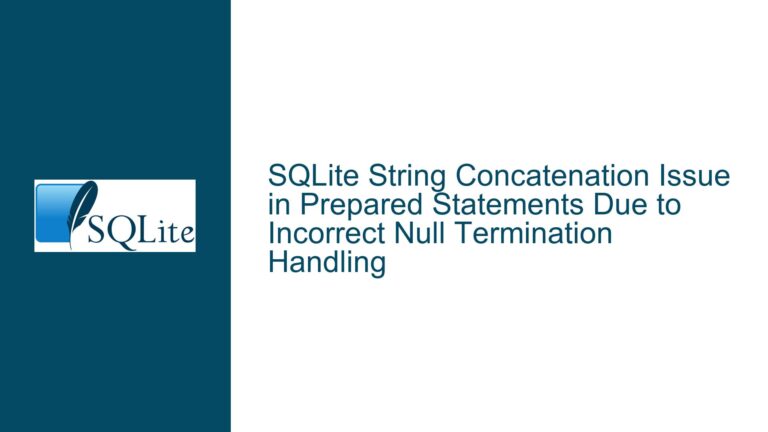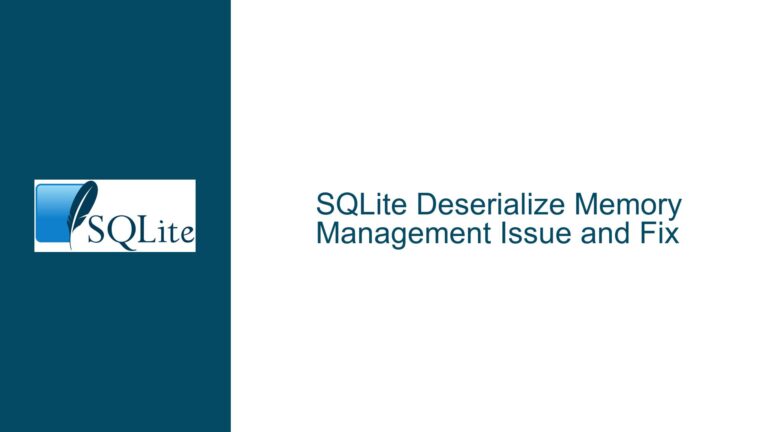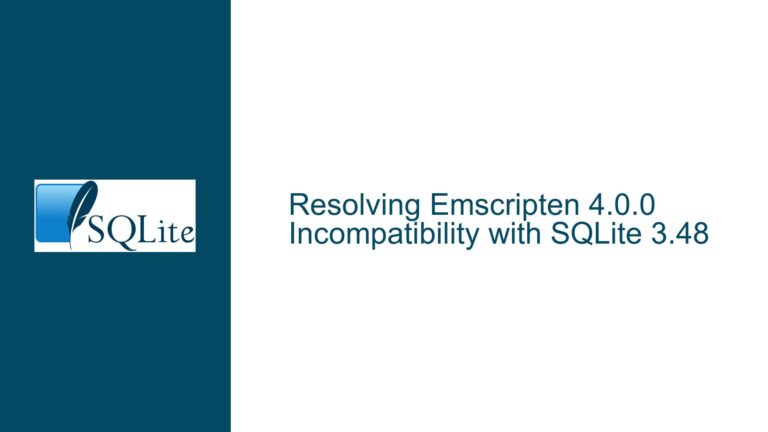SQLite WAL Mode Failure on VxWorks Due to Shared Memory Disabled
SQLite WAL Mode Configuration Fails on VxWorks with HRFS
When attempting to configure SQLite to use Write-Ahead Logging (WAL) mode on VxWorks 7 with the HRFS file system, the operation fails, and the journal mode reverts to "delete" instead of "WAL". This issue arises despite other journal modes functioning correctly. The problem is rooted in the interaction between SQLite’s WAL mode requirements and the underlying operating system and file system capabilities, specifically the lack of shared memory support.
SQLite’s WAL mode is designed to enhance concurrency and performance by allowing multiple readers and a single writer to operate simultaneously. However, this mode relies heavily on shared memory for synchronization between processes. When SQLite is configured to use WAL mode, it attempts to create and manage shared memory segments to coordinate access to the database. If the underlying system does not support shared memory or if the necessary shared memory functions are not implemented, SQLite will fall back to the default "delete" journal mode.
In the case of VxWorks 7 with HRFS, the issue is exacerbated by the fact that SQLite’s internal configuration for VxWorks explicitly disables shared memory support. This is evident from the SQLite source code, where the IOMETHODS macro is defined with shared memory disabled (1 indicates shared memory is disabled). This configuration prevents SQLite from utilizing shared memory, which is a prerequisite for WAL mode.
Shared Memory Disabled in SQLite for VxWorks
The core issue preventing SQLite from entering WAL mode on VxWorks 7 with HRFS is the lack of shared memory support. Shared memory is a critical component of SQLite’s WAL implementation, as it allows multiple processes to coordinate access to the database. Without shared memory, SQLite cannot maintain the necessary synchronization mechanisms, forcing it to revert to the "delete" journal mode.
The SQLite source code reveals that shared memory is explicitly disabled for VxWorks. The IOMETHODS macro, which defines the I/O methods for SQLite on VxWorks, includes a parameter that disables shared memory (1). This parameter indicates that the xShmMap method, which is responsible for mapping shared memory, is not implemented. As a result, SQLite cannot create or manage shared memory segments, rendering WAL mode unusable.
Furthermore, the issue is compounded by changes in SQLite’s implementation over time. Earlier versions of SQLite, such as 3.8.0.2, included a built-in shared memory mapping function (unixShmMap) that was compatible with VxWorks. However, this function has been removed in later versions, leaving VxWorks users without a built-in solution for shared memory management. This removal has effectively broken WAL mode functionality for VxWorks users unless they implement their own shared memory mapping function.
Implementing Custom Shared Memory Support for WAL Mode
To resolve the issue and enable WAL mode on VxWorks 7 with HRFS, it is necessary to implement custom shared memory support. This involves creating a shared memory mapping function that SQLite can use to manage shared memory segments. The following steps outline the process of implementing this solution:
Implement the
xShmMapMethod: The first step is to implement thexShmMapmethod, which is responsible for mapping shared memory segments. This method must be compatible with VxWorks and HRFS, ensuring that it can create, manage, and synchronize shared memory segments effectively. The implementation should follow the same interface as the originalunixShmMapfunction, allowing SQLite to integrate it seamlessly.Modify the IOMETHODS Macro: Once the
xShmMapmethod is implemented, the IOMETHODS macro in the SQLite source code must be updated to include this new method. This involves changing the parameter that disables shared memory (1) to enable it (0) and adding the newxShmMapmethod to the list of I/O methods. This modification ensures that SQLite recognizes and uses the custom shared memory implementation.Recompile SQLite: After implementing the
xShmMapmethod and updating the IOMETHODS macro, SQLite must be recompiled to include these changes. This step ensures that the custom shared memory support is integrated into the SQLite binary, allowing it to function correctly on VxWorks 7 with HRFS.Test WAL Mode Functionality: Once SQLite has been recompiled with the custom shared memory support, it is essential to test WAL mode functionality thoroughly. This involves creating a new database, configuring it to use WAL mode, and verifying that it operates as expected. Testing should include scenarios with multiple readers and writers to ensure that the shared memory implementation handles concurrency correctly.
Optimize Shared Memory Performance: After confirming that WAL mode works correctly, it may be necessary to optimize the shared memory implementation for performance. This could involve tuning the size of shared memory segments, improving synchronization mechanisms, or reducing contention between processes. Optimization ensures that WAL mode provides the expected performance benefits on VxWorks 7 with HRFS.
By following these steps, it is possible to implement custom shared memory support for SQLite on VxWorks 7 with HRFS, enabling WAL mode and unlocking its performance and concurrency benefits. This solution addresses the root cause of the issue, providing a robust and reliable way to use WAL mode in environments where shared memory support is not available out of the box.
Conclusion
The inability to configure SQLite to use WAL mode on VxWorks 7 with HRFS is a result of the lack of shared memory support in SQLite’s internal configuration for VxWorks. This issue can be resolved by implementing custom shared memory support, including the xShmMap method, updating the IOMETHODS macro, and recompiling SQLite. Once these steps are completed, WAL mode can be enabled, providing the performance and concurrency benefits that make it a valuable feature for database applications.
This solution not only addresses the immediate issue but also highlights the importance of understanding the underlying requirements and dependencies of database features like WAL mode. By taking a systematic approach to troubleshooting and implementing custom solutions, it is possible to overcome limitations imposed by specific operating systems and file systems, ensuring that SQLite can be used effectively in a wide range of environments.






